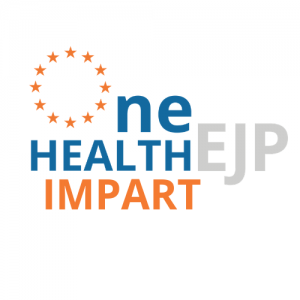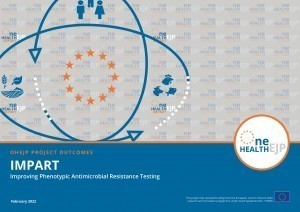Heidelberglaan 100, Utrecht, Utrecht, The Netherlands
Anker Engelunds Vej 1, Stampen, Region Hovedstaden, Denmark
Waterloo Road, London Borough of Lambeth, England, United Kingdom
RIVM
P.O. Box 1
3720 BA Bilthoven
The Netherlands
Puławy, Lublin, Poland
Uppsala, Sweden
Artillerivej 5, Copenhagen, Region Hovedstaden, Denmark
Ullevålsveien 68, Oslo, Oslo, Norway
Max-Dohrn-Straße 8, Berlin, Berlin, Germany
Addlestone, England, United Kingdom
14 Rue Pierre et Marie Curie, Maisons-Alfort, Île-de-France, France

The Project #IMPART
| Start: | 1 January 2018 |
| Duration: | 2 Years |
| Domain: | Antimicrobial Resistance |
| Keywords: | Colistin, Carbapenemase, ECOFF, AMR surveillance, AST interpretation, Clostridium difficile |
| Contact: | Kees Veldman (WUR) |
IMPART: Improving phenotypic Antimicrobial Resistance Testing by development of sensitive screening assays for emerging resistances, and setting missing ECOFFs.
IMPART consisted of four topics related to the development and harmonization of phenotypic methods for detection of antimicrobial resistance, in line with the Commission’s Action Plan Against the rising threats from Antimicrobial Resistance: Road Map (updated on November 2016):
- selective isolation and detection of colistin-resistant Enterobacterales,
- selective isolation and detection of carbapenemase-producing Enterobacterales,
- development of a standardized disk diffusion method for susceptibility testing of Clostridium difficile,
- setting epidemiological cut-off values (ECOFFs) to determine the susceptibility of specific animal pathogens to veterinary antimicrobials.
Project Outputs and Outcomes
To achieve the goal for the harmonization of the isolation, detection and characterisation of colistin-resistant Enterobacterales, the IMPART consortium performed in depth review of available methods. The detection protocol described in the project is comprised of a two-step screening involving a PCR step and culturing of PCR positive samples on selective chromogenic agar media specific for colistin-resistant Enterobacterales. A multicentre trial was conducted between eleven participants to evaluate the performance of the protocol. The pre-screening PCR step gives the opportunity to save time and consumables, and is 90% accurate. Further, the results show that one of the commercial agar plates available on the market has a good sensitivity to detect mcr-positive Escherichia coli and Salmonella spp. More colistin-resistant strains need to be included to assess the robustness of the method.
For the carbapenem-resistant Enterobacterales (CPE), a similar multicentre study with eleven participants was conducted to test the protocol used for monitoring in most national reference laboratories. Samples were plated onto commercially available selective agar media after non-selective enrichment (as in the Decision 2013/652/EU and 2020/1729/EU). Further, isolated colonies were used for species identification and AMR testing by phenotypic (microdilution and disk diffusion) or genotypic (PCR) methods. The results from this study showed that the tested selective agar plates performed well on CPE strains but have difficulties to detect low-level carbapenemase producers. There are also no commercial selective agar plates, which are chromogenic for detecting carbapenem-resistant Salmonella spp.
The outputs from these two multicentre studies could be of interest for the European Food Safety Authority (EFSA) and the EU Reference Laboratory for antimicrobial resistance (EURL-AR), to evaluate protocols in the antimicrobial surveillance programme. Commercial manufacturers could also be interested to improve the performance of their selective media.
Regarding the antimicrobial susceptibility testing (AST) of C. difficile, the IMPART project aimed at providing a cost-effective, robust and simple method for routine purposes as well as for low throughput analyses. By comparing e.g. different anaerobic conditions, the minimum requirements for reproducible analyses using disk diffusion were defined and an optimized method description was provided. This optimized protocol was further validated in an international ring trial study. By analysing app. 500 C. difficile strains by agar dilution and disk diffusion in parallel, we were able to propose cut-off values to distinguish wild type from non-wild type strains using the disk diffusion method. In conclusion, an AST procedure for C. difficile that can be used worldwide by any laboratory was optimized and validated in this project.
The setting of ECOFFs for veterinary pathogens will highly improve harmonization of monitoring of resistance in animal pathogens and support the process for defining animal species-specific clinical breakpoints for veterinary antimicrobials that will ultimately lead to more effective and prudent use of antimicrobials in animals. In close cooperation with the European Committee on Antimicrobial Susceptibility Testing (EUCAST), new epidemiological cut-off values (ECOFFS) were established for Staphylococcus pseudintermedius, Staphylococcus hyicus, Mannheimia haemolytica and Pasteurella multocida and are now available on the EUCAST website (www.eucast.org). As a direct result of this work, VetCAST (the veterinary subcommittee of EUCAST) is developing new clinical breakpoints for veterinary antimicrobials.
The Project impact Brochure is available on Zenodo.
Project Assets
Perrin-Guyomard, A., Granier, S.A., Slettemeås, J.S., Anjum, M., Randall, L., AbuOun, M., Pauly, N., Irrgang, A., Hammerl, J.A., Kjeldgaard, J.S., Hammerum, A., Franco, A., Skarżyńska, M., Kamińska, E., Wasyl, D., Dierikx, C., Börjesson, S., Geurts, Y., Haenni, M. and Veldman, K. (2022). Multicentre evaluation of a selective isolation protocol for detection of mcr-positive E. coli and Salmonella spp. in food-producing animals and meat. Letters in Applied Microbiology. Early view. DOI: https://doi.org/10.1111/lam.13717
Dierikx C., Börjesson S., Perrin-Guyomard A., Haenni M., Norström M., Divon H. H., Ilag H. K., Granier S. A., Hammerum A., Sejer Kjeldgaard J., Pauly N., Randall L., Anjum M. F., Smialowska A., Franco A., Veldman K., Schau Slettemeås J. (2022). A European multicenter evaluation study to investigate the performance on commercially available selective agar plates for the detection of carbapenemase producing Enterobacteriaceae. Journal of Microbiological Methods. 193:106418 DOI: https://doi.org/10.1016/j.mimet.2022.106418.
Pauly, N., Hammerl, J. A., Grobbel, M., Käsbohrer, A., Tenhagen, B-A., Malorny, B., Schwarz, S., Meemken, D., Irrgang, A. (2021). Identification of a blaVIM-1-Carrying IncA/C2 Multiresistance Plasmid in an Escherichia coli Isolate Recovered from the German Food Chain. Microorganisms. 9(1), 29. DOI: https://doi.org/10.3390/microorganisms9010029
Perrin-Guyomard, A., Granier, S., Haenni, M., Slettemeås, J. S., Ilag, H. K., Anjum, M., Randall, L., AbuOun, M., Pauly, N., Irrgang, A., Hammerl, J. A., Svendsen, C. A., Kjeldgaard, J. S., Hammerum, A., Franco, A., Skarżyńska, M., Kamińska, E., Wasyl, D., Dierikx, C., Börjesson, S., Geurts, Y. & Veldman, K. (2021). Multicentre evaluation of culture based methods to selectively isolate Colistin-resistant Enterobacteriaceae from food producing animals and food products. Poster presentation at OHEJP Annual Scientific Meeting 2021, Copenhagen, Denmark. 9-11 June 2021. DOI: https://doi.org/10.5281/zenodo.7390564
Pauly, N., Klaar, Y., Skladnikiewicz-Ziemer, T., Juraschek, K., Grobbel, M., Hammerl, JA., Hemmers, L., Käsbohrer, A., Schwarz, S., Meemken, D., Tenhagen, B-A., Irrgang, A. (2021). Isolation Procedure for CP E. coli from Caeca Samples under Review towards an Increased Sensitivity. Microorganisms. 9, 1105. DOI: https://doi.org/10.3390/microorganisms9051105
Pauly, N., Hammerl, J. A., Grobbel, M., Käsbohrer, A., Tenhagen, B-A., Malorny, B., Schwarz, S., Meemken, D., Irrgang, A. (2020). Identification of a blaVIM-1-Carrying IncA/C2 Multiresistance Plasmid in an Escherichia coli Isolate Recovered from the German Food Chain. Microorganisms. 9, 29. DOI: https://doi.org/10.3390/%20microorganisms9010029
Pauly, N., Hammerl, JA., Schwarz, S., Grobbel, M., Meemken, D., Malorny, B., Tenhagen, BA., Käsbohrer, A., Irrgang, A. (2020). Co-occurrence of the blaVIM-1 and blaSHV-12 genes on an IncHI2 plasmid of an Escherichia coli isolate recovered from German livestock. Journal of Antimicrobial Chemotherapy. 76(2), 531–533. DOI: https://doi.org/10.1093/jac/dkaa436
Diaconu, EL., Carfora, V., Alba, P., Di Matteo, P., Stravino, F., Buccella, C., Dell’Aira, E., Onorati, R., Sorbara, L., Battisti, A., Franco, A. (2020). Novel IncFII plasmid harbouring blaNDM-4 in a carbapenem-resistant Escherichia coli of pig origin, Italy. Journal of Antimicrobial Chemotherapy. 75(12), 3475–3479. DOI: https://doi.org/10.1093/jac/dkaa374
Irrgang, A., Tausch SH., Pauly, N., Grobbel, M., Kaesbohrer, A,. Hammerl, JA. (2020). First Detection of GES-5-Producing Escherichia coli from Livestock—An Increasing Diversity of Carbapenemases Recognized from German Pig Production. Microorganisms. 8 (10), 159. DOI: https://doi.org/10.3390/microorganisms8101593
Pauly, N., Hammerl, JA., Grobbel, M., Tenhagen, BA., Käsbohrer, A., Bisenius, S., Fuchs, J., Horlacher, S., Lingstädt, H., Mauermann, U., Mitro, S., Müller, M., Rohrmann, S., Schiffmann, AP., Stührenberg, B., Zimmermann, P., Schwarz, S., Meemken, D., Irrgang, A. (2020). ChromID® CARBA Agar Fails to Detect Carbapenem-Resistant Enterobacteriaceae With Slightly Reduced Susceptibility to Carbapenems. Frontiers in Microbiology. 11, 1678. DOI: https://doi.org/10.3389/fmicb.2020.01678
Irrgang, A., Pauly, N., Tenhagen, BA., Grobbel, M., Kaesbohrer, A., Hammerl, JA. (2020). Spill-Over from Public Health? First Detection of an OXA-48-Producing Escherichia coli in a German Pig Farm. Microorganisms. 8(6), 855. DOI: https://doi.org/10.3390/microorganisms8060855
Veldman, K., Slettemeås, JS., Granier, S., Perrin-Guyomard, A., Hechard, T., Dierikx, C., Maurischat, S. (2020). IMPART: an update of the study. Poster presented at One Health EJP Annual Scientific Meeting 2020. Online, 27-29th May 2020. DOI: https://doi.org/10.5281/zenodo.4066734
Veldman, K., Slettemeås, JS., Grobbel, M., Börjesson, S., Dors, A., Franco, A., Haenni, M., Turner, O., Broens, E. (2020). Susceptibility testing of veterinary pathogenic bacteria as a first step in setting new epidemiological cut-off values (ECOFFs). Poster presented at: One Health EJP Annual Scientific Meeting 2020. Online, 27-29th May 2020. DOI: https://doi.org/10.5281/zenodo.4066667
Maurischat, S., Witt, P., Maneck, C., Grobbel, M. and the OHEJP IMPART consortium (2020). Clostridioides difficile antimicrobial susceptibility testing using disc diffusion. Poster presented at: One Health EJP Annual Scientific meeting, 2020. Online, 27-29th May 2020. DOI: https://doi.org/10.5281/zenodo.7390483
Slettemeås, JS., Norström, M., Divon, H., Ilag, HK., Granier, S., Perrin-Guyomard, A., Haenni, M., Veldman, K., Hammerum, A., Börjesson, S., Kjeldgaard, JS., Irrgang, A., Dierikx, C., Randall, L., Smialowska, A., Franco, A. (2020). A multicenter study examining different culturing methods to detect carbapenemase-producing Enterobacteriaceae. Poster presented at One Health EJP Annual Scientific Meeting 2020. Online, 27-29th May 2020. DOI: https://doi.org/10.5281/zenodo.4066631
Project
Project Presentations
JRP IMPART project – Key outputs, expected outcomes and expected impact – presentation at Scientific Steering Board (SSB) meeting 15.09.21
JRP IMPART project – Outcomes and expected impact – presentation at POC PMC meeting 24.11.21 & PDF version
JRP IMPART project – Gaps identified, main results, impact towards stakeholders – presentation at POC PMC meeting 22.11.22
Presentation of two outcomes of IMPART in the EURL-AR newsletter No. 16 December 2022
Jannice Schau Slettemeås and Kees Veldman on behalf of the IMPART consortium, A European multicenter evaluation study to investigate the performance on commercially available selective agar plates for the detection of Carbapenemase Producing Enterobacteriaceae.
Agnès Perrin-Guyomard and Kees Veldman on behalf of the IMPART consortium, Multicentre evaluation of a selective isolation protocol for detection of mcr positive E. coli and Salmonella spp. in food-producing animals and meat.




